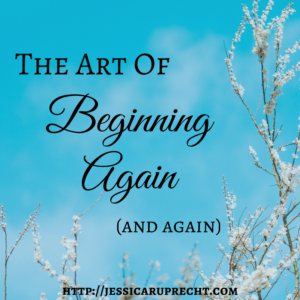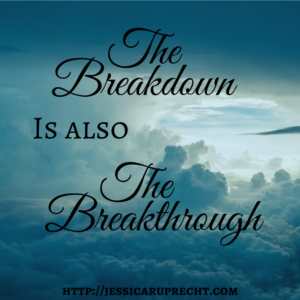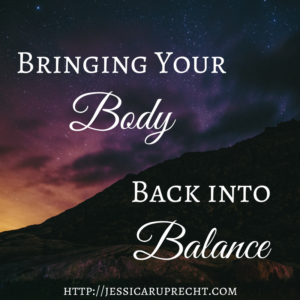 The truth is this: I don’t think I’ve written anything more serious than a journal entry in almost six months (not counting academic publications, that is).
The truth is this: I don’t think I’ve written anything more serious than a journal entry in almost six months (not counting academic publications, that is).
And even that truth is something of a lie because I have written some things, I have an unfinished draft or two of a blog post hanging out on my computer that I never polished up and published and an even longer list of possible blog titles I liked enough to jot down, but never followed through on.
I haven’t written for a long list of reasons — among them, I’ve been focused on healing several chronic health issues (progress has been mixed, but there has been progress) and that lately the time has never felt right (hint: the time will never feel right).
All of which is to say that this blog post is about beginning again (and again). Because as much as I like to tell myself the story that it is enough to begin something once and then to keep going — the truth is always that I begin something once and then life derails me and I find myself needing to begin over and over again.
So today, I thought I’d share just a few tips for how to begin again with grace.
First, honor the truth that this is how life is.
Life is full of difficulties you failed to account for: a bad night’s sleep, an unexpectedly dead phone, a serious illness. These difficulties come in all shapes and sizes and their most important shared feature is that, no matter how carefully you planned or how diligently you agonized, you could not have accounted for them.
The important thing isn’t that these things happen — it’s how we choose to respond when they do.
If we sleep badly do we slack off because we’re exhausted and then feel guilty about how little we’re accomplishing? Or do we take a cold, hard look at our plans for the day and say, “Here’s the two key things that I have the energy to accomplish today. Everything else will have to wait for tomorrow” — and then we follow through on that: we do our two things and are done for the day.
The way to more forward with grace when life throws up an unexpected roadblock is to keep coming home to the truth of our reality in each moment.
Today my reality is that I am tired. Today my reality is that I have needed to scale back on some of the things I had hoped to accomplish.
But today my reality is also that I have managed to do many of the things that I intended to do — and that this is cause for celebration, not punishment. In my own way, I am triumphing despite adverse circumstances — should I choose to view my actions in this way.
Second, offer yourself compassion instead of judgement.
This is the one thing that has made the biggest difference in my life.
I used to have this terribly toxic inner dialogue where every missed deadline was a disaster and every broken promise (to myself, mostly, but sometimes to other people) proved what a terrible, unreliable person I was.
But the truth about living this way is it makes you feel hunted.
Your own scathing inner voices haunt you, until you are terrified to drop the ball on even one small thing for fear of the furious criticism that will issue from the bully that lives inside your mind.
Being constantly on the run from your own inner critic doesn’t work very well.
When you’re on the run, nothing you achieve feels like a victory — it feels like a commuted death sentence or a bullet dodged — a terror-tainted relief, unworthy of jubilation.
Happily, if you are also guilty of a toxic inner dialogue, this is a pattern that can be shifted with mindful awareness and the conscious development and regular practice of self-compassion.
It is possible to recognize that our terribly mean inner voices are fueled by nothing more than our fear: fear that we are not good enough, fear that we will be rejected, fear that others will shame or abandon us if we dare to let them down.
These fears are natural, normal, healthy human fears.
We’re afraid of being alone. We’re afraid of feeling vulnerable. And the fear centers of our brain are working overtime to try and keep us safe and out of danger.
But it is possible to honor our instincts and our fears without succumbing to them.
It is possible to hold our instincts and our fears with compassionate witness and to choose to take a different path. It is possible to choose to honor and navigate our fears with compassion. To offer the smallest, most frightened parts of ourselves our love and protection.
Third, safety is what makes change possible.
The strength needed to begin again (and again) is so much less when we feel safe.
In meditation we come back to the breath over and over again. And we become distracted over and over again — because it is the nature of the mind to wander.
But with practice, we learn that what matters the most is not preventing distraction. What matters the most is how we choose to come back to the breath.
When I first started meditating, years ago, I came back to the breath like this: “Oh, shoot, thinking… Thinking. Again! Argh!… Crap, still thinking…” Needless to say, I often finished my meditation frustrated with myself, my mind, and my own lack of concentration.
These days, I come back to the breath more like this: “Oh, hello thinking…. Planning, thank you for your concern… Past — how good to see you today…” And in between this friendly noticing of what my mind is up to, I generally experience calm and peace.
And when I feel agitated, restless, bored, and uncomfortable — when peace seems farther away than anything — I notice that with friendliness and compassion, too.
The critical thing that changed was this: I stopped judging myself for becoming distracted and, in doing so, I turned my meditation into an experience that was safe.
Safe to fail. Safe to forget. Safe to start over again.
Because truly, I believe that when make our lives safe for ourselves to live in anything is possible.
And the good news is, most of creating safety for yourself is an inside job.
It’s learning to listen to your fears and outrages and desires. It’s learning to separate your scary story and your insecurity from what is really happening. It’s learning to trust yourself to navigate change and hardship capably and with as much grace as is possible.
It’s the simple (and yet amazingly difficult) commitment to be the one person who will never abandon you. To stick with your body, your feelings, and your circumstances no matter how rough the seas or how fierce the winds.
And if you can do that, you can do anything.
Much love,
Jessica
 Years ago at a college party someone remarked to me that drunk people walk like this: fine, fine, fine, fine — oh sh*t, falling. Parties were really never my scene, but that image stuck with me and I remember it to this day because it seemed like a really good metaphor.
Years ago at a college party someone remarked to me that drunk people walk like this: fine, fine, fine, fine — oh sh*t, falling. Parties were really never my scene, but that image stuck with me and I remember it to this day because it seemed like a really good metaphor. The highest priority of body and brain are to protect you from danger and remove you from stressful situations.
The highest priority of body and brain are to protect you from danger and remove you from stressful situations.  I’ve been thinking a lot about courage and strength the past few weeks. Like many of you, I’ve felt called to step outside of my comfort zone in new ways — in forms ranging from contacting my congressional representatives to beginning work on a new ebook.
I’ve been thinking a lot about courage and strength the past few weeks. Like many of you, I’ve felt called to step outside of my comfort zone in new ways — in forms ranging from contacting my congressional representatives to beginning work on a new ebook.